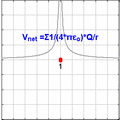Electric potential facts for kids
Electric potential is a way to measure how much electric potential energy (EPE) a charged object has for each unit of its electric charge. Think of it as the amount of energy (measured in joules) you get for every unit of charge (measured in coulombs).
The unit for electric potential is the joule per coulomb. This unit is also called the volt, named after Alessandro Volta. So, one volt means one joule of energy for every coulomb of charge.
Contents
Understanding Electric Potential
Imagine water in a pond high up in the hills. This water has a lot of gravitational potential energy because it's high above the ground. When the water flows downhill, it loses energy.
Let's say one pond has 100 liters of water and 1000 joules of energy. This means it has 10 joules of energy for every liter of water. Another pond, lower down, might also have 100 liters of water but only 500 joules of energy. This pond has 5 joules per liter.
Electric potential works in a similar way. Instead of water, we have electric charges. Instead of height, we have electric potential. If you have 100 coulombs of charge with 1000 joules of electric potential energy, the electric potential is 10 joules per coulomb (or 10 volts). In another part of an electric circuit, the electric potential might be 5 joules per coulomb (or 5 volts).
How Charges Move
Just like water flows from a higher place to a lower place, electric charges tend to "fall" from a place with higher electric potential to a place with lower electric potential. They always move towards where they have less electric potential energy.
For example, a charged object might move from a spot with an electric potential of 10 volts to a spot with an electric potential of 5 volts. If this object has 20 coulombs of charge, its electric potential energy would change from 200 joules (20 coulombs x 10 volts) to 100 joules (20 coulombs x 5 volts).
Electric Potential vs. Electric Potential Energy
It's important to remember that electric potential is not the same as electric potential energy. Electric potential is the energy per unit of charge. Electric potential energy is the total energy stored in a charged object or system.
Electric potential is also different from electric potential difference. Electric potential difference is often called voltage. It measures the difference in electric potential between two points.
Volts and Voltage
The volt is a unit that we use to measure electric potential and voltage. For example, a battery might be 9 volts (9 V).
When we talk about voltage in a formula, we often use a lowercase 'v' as its symbol. For example, in the formula for Ohm's law, voltage equals current times resistance (v = ir). This helps us tell the difference between the unit (V) and the quantity (v). Electrical engineers sometimes use 'e' for voltage to make it even clearer.
Images for kids
See also
 In Spanish: Potencial eléctrico para niños
In Spanish: Potencial eléctrico para niños


